Integrated Marketing Communications Plan for CBA Bank, Australia
VerifiedAdded on 2023/06/07
|21
|4529
|462
Report
AI Summary
This report presents an integrated marketing communications (IMC) plan for the Commonwealth Bank of Australia (CBA) to address recent challenges to its brand image. The plan leverages various marketing tools, including advertising, personal selling, sponsorship, public relations, sales promotion, internet marketing, and direct marketing, to cultivate a positive impression among existing and prospective customers. It details the communication strategy mix, media mix, and creative approaches across television, radio, print, billboards, and social media. The report also includes evaluation metrics for measuring success and a basic budget estimate. The core strategy focuses on mitigating the effects of negative publicity through a comprehensive promotional approach, emphasizing adjustments to existing tools and strategies. The IMC plan aims to reinforce CBA's position as a leading bank in Australia by rebuilding trust and enhancing customer engagement through consistent and strategic communications.
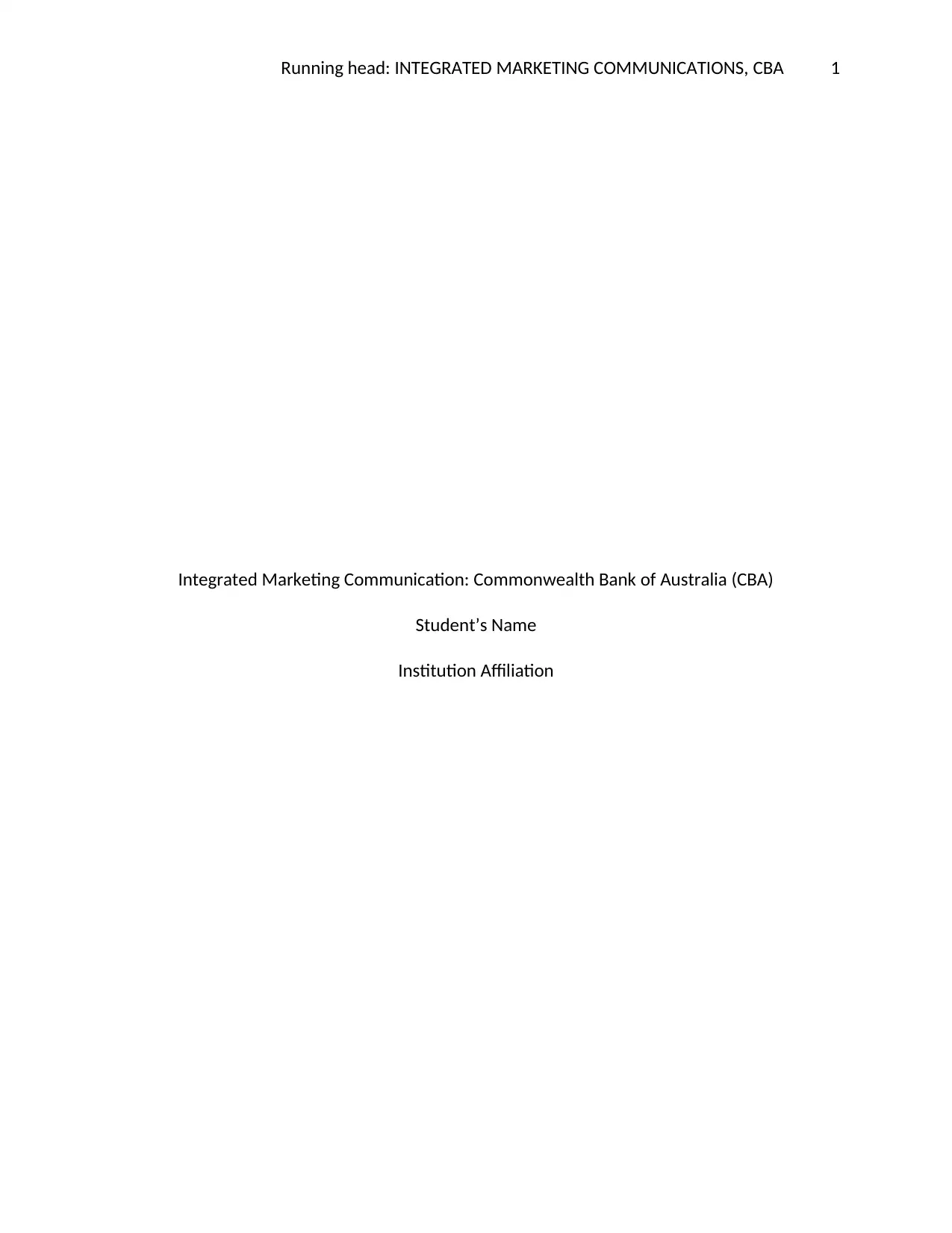
Running head: INTEGRATED MARKETING COMMUNICATIONS, CBA 1
Integrated Marketing Communication: Commonwealth Bank of Australia (CBA)
Student’s Name
Institution Affiliation
Integrated Marketing Communication: Commonwealth Bank of Australia (CBA)
Student’s Name
Institution Affiliation
Paraphrase This Document
Need a fresh take? Get an instant paraphrase of this document with our AI Paraphraser
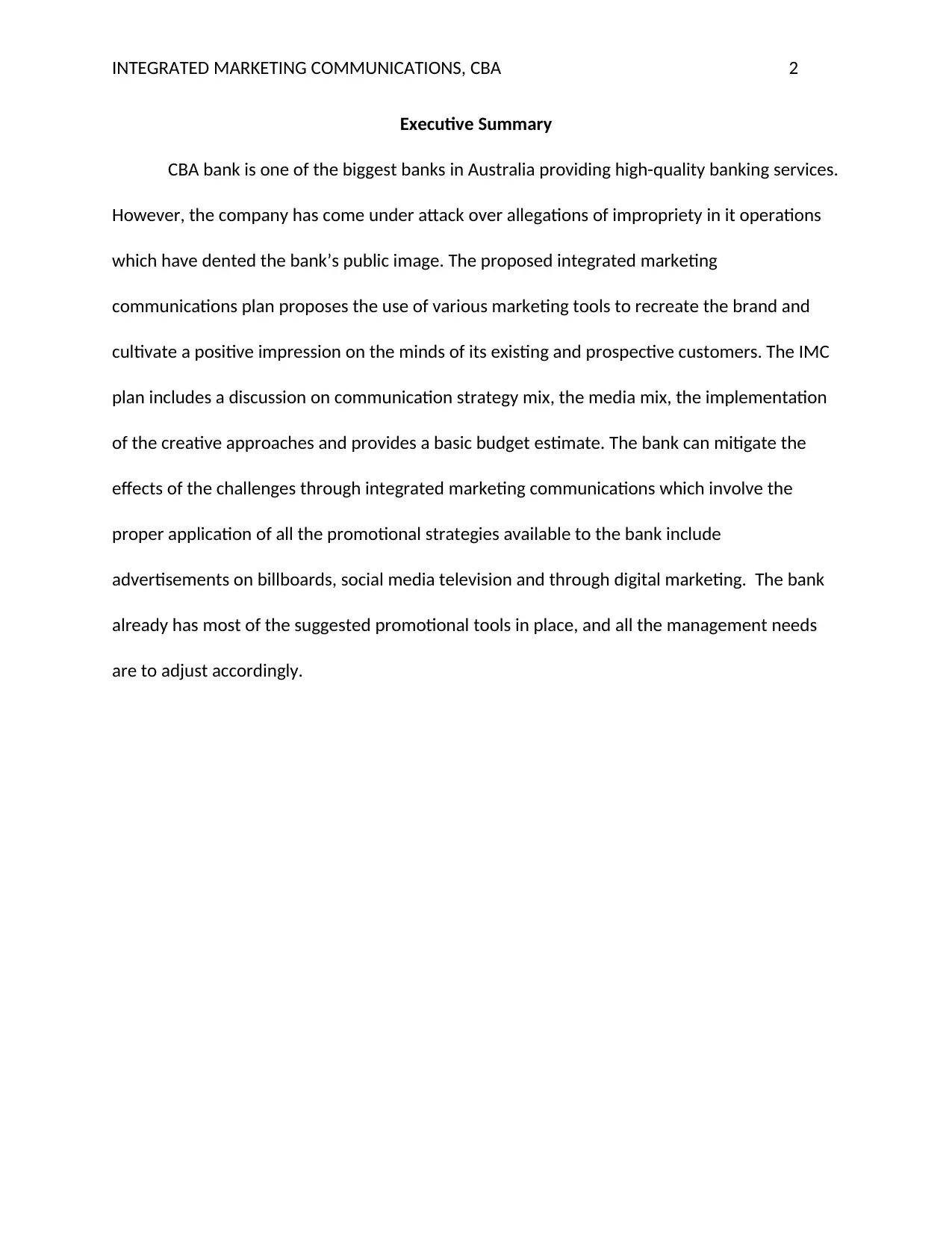
INTEGRATED MARKETING COMMUNICATIONS, CBA 2
Executive Summary
CBA bank is one of the biggest banks in Australia providing high-quality banking services.
However, the company has come under attack over allegations of impropriety in it operations
which have dented the bank’s public image. The proposed integrated marketing
communications plan proposes the use of various marketing tools to recreate the brand and
cultivate a positive impression on the minds of its existing and prospective customers. The IMC
plan includes a discussion on communication strategy mix, the media mix, the implementation
of the creative approaches and provides a basic budget estimate. The bank can mitigate the
effects of the challenges through integrated marketing communications which involve the
proper application of all the promotional strategies available to the bank include
advertisements on billboards, social media television and through digital marketing. The bank
already has most of the suggested promotional tools in place, and all the management needs
are to adjust accordingly.
Executive Summary
CBA bank is one of the biggest banks in Australia providing high-quality banking services.
However, the company has come under attack over allegations of impropriety in it operations
which have dented the bank’s public image. The proposed integrated marketing
communications plan proposes the use of various marketing tools to recreate the brand and
cultivate a positive impression on the minds of its existing and prospective customers. The IMC
plan includes a discussion on communication strategy mix, the media mix, the implementation
of the creative approaches and provides a basic budget estimate. The bank can mitigate the
effects of the challenges through integrated marketing communications which involve the
proper application of all the promotional strategies available to the bank include
advertisements on billboards, social media television and through digital marketing. The bank
already has most of the suggested promotional tools in place, and all the management needs
are to adjust accordingly.
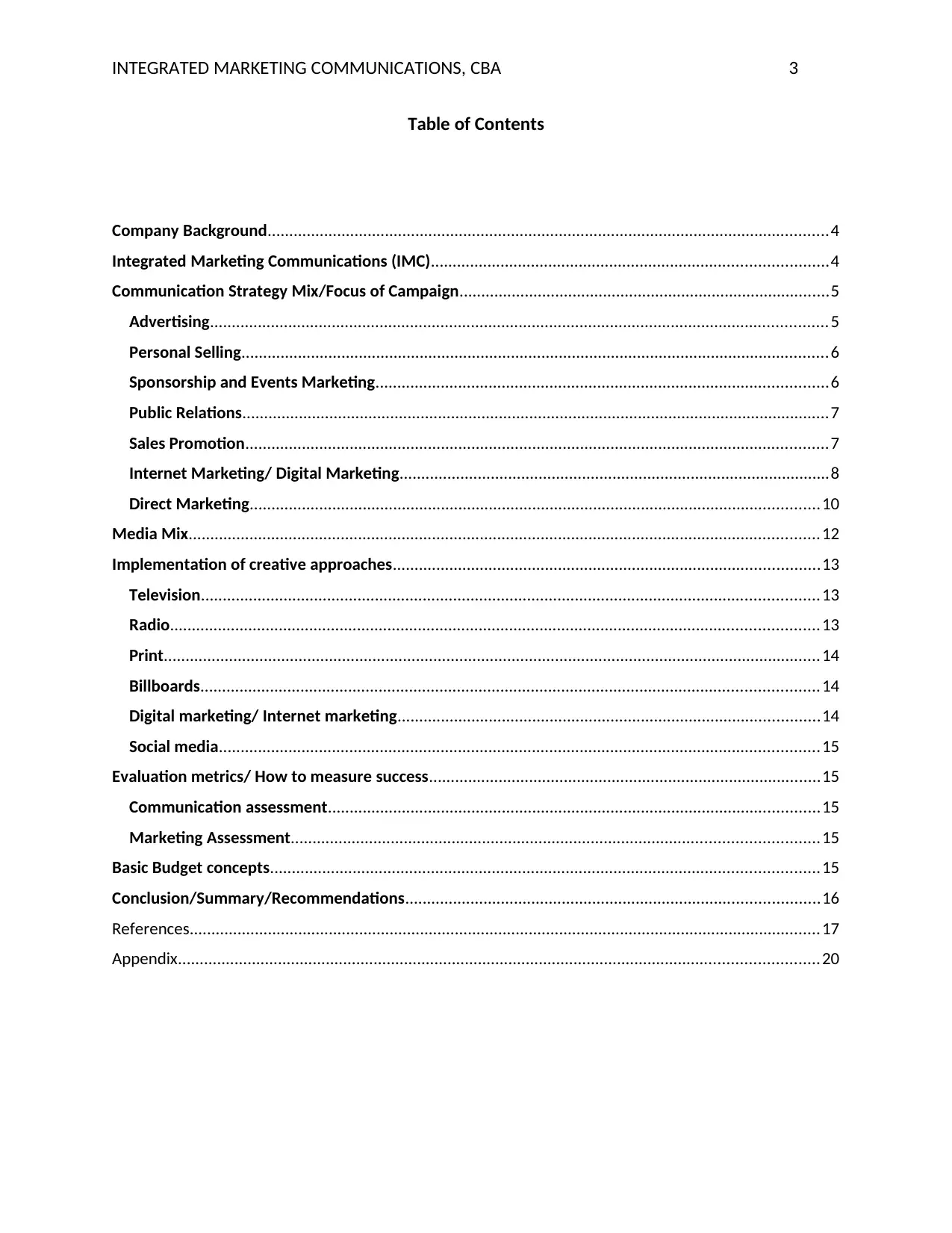
INTEGRATED MARKETING COMMUNICATIONS, CBA 3
Table of Contents
Company Background.................................................................................................................................4
Integrated Marketing Communications (IMC)...........................................................................................4
Communication Strategy Mix/Focus of Campaign.....................................................................................5
Advertising..............................................................................................................................................5
Personal Selling.......................................................................................................................................6
Sponsorship and Events Marketing........................................................................................................6
Public Relations.......................................................................................................................................7
Sales Promotion......................................................................................................................................7
Internet Marketing/ Digital Marketing...................................................................................................8
Direct Marketing...................................................................................................................................10
Media Mix.................................................................................................................................................12
Implementation of creative approaches..................................................................................................13
Television..............................................................................................................................................13
Radio.....................................................................................................................................................13
Print.......................................................................................................................................................14
Billboards..............................................................................................................................................14
Digital marketing/ Internet marketing.................................................................................................14
Social media..........................................................................................................................................15
Evaluation metrics/ How to measure success..........................................................................................15
Communication assessment.................................................................................................................15
Marketing Assessment.........................................................................................................................15
Basic Budget concepts..............................................................................................................................15
Conclusion/Summary/Recommendations...............................................................................................16
References.................................................................................................................................................17
Appendix...................................................................................................................................................20
Table of Contents
Company Background.................................................................................................................................4
Integrated Marketing Communications (IMC)...........................................................................................4
Communication Strategy Mix/Focus of Campaign.....................................................................................5
Advertising..............................................................................................................................................5
Personal Selling.......................................................................................................................................6
Sponsorship and Events Marketing........................................................................................................6
Public Relations.......................................................................................................................................7
Sales Promotion......................................................................................................................................7
Internet Marketing/ Digital Marketing...................................................................................................8
Direct Marketing...................................................................................................................................10
Media Mix.................................................................................................................................................12
Implementation of creative approaches..................................................................................................13
Television..............................................................................................................................................13
Radio.....................................................................................................................................................13
Print.......................................................................................................................................................14
Billboards..............................................................................................................................................14
Digital marketing/ Internet marketing.................................................................................................14
Social media..........................................................................................................................................15
Evaluation metrics/ How to measure success..........................................................................................15
Communication assessment.................................................................................................................15
Marketing Assessment.........................................................................................................................15
Basic Budget concepts..............................................................................................................................15
Conclusion/Summary/Recommendations...............................................................................................16
References.................................................................................................................................................17
Appendix...................................................................................................................................................20
⊘ This is a preview!⊘
Do you want full access?
Subscribe today to unlock all pages.

Trusted by 1+ million students worldwide
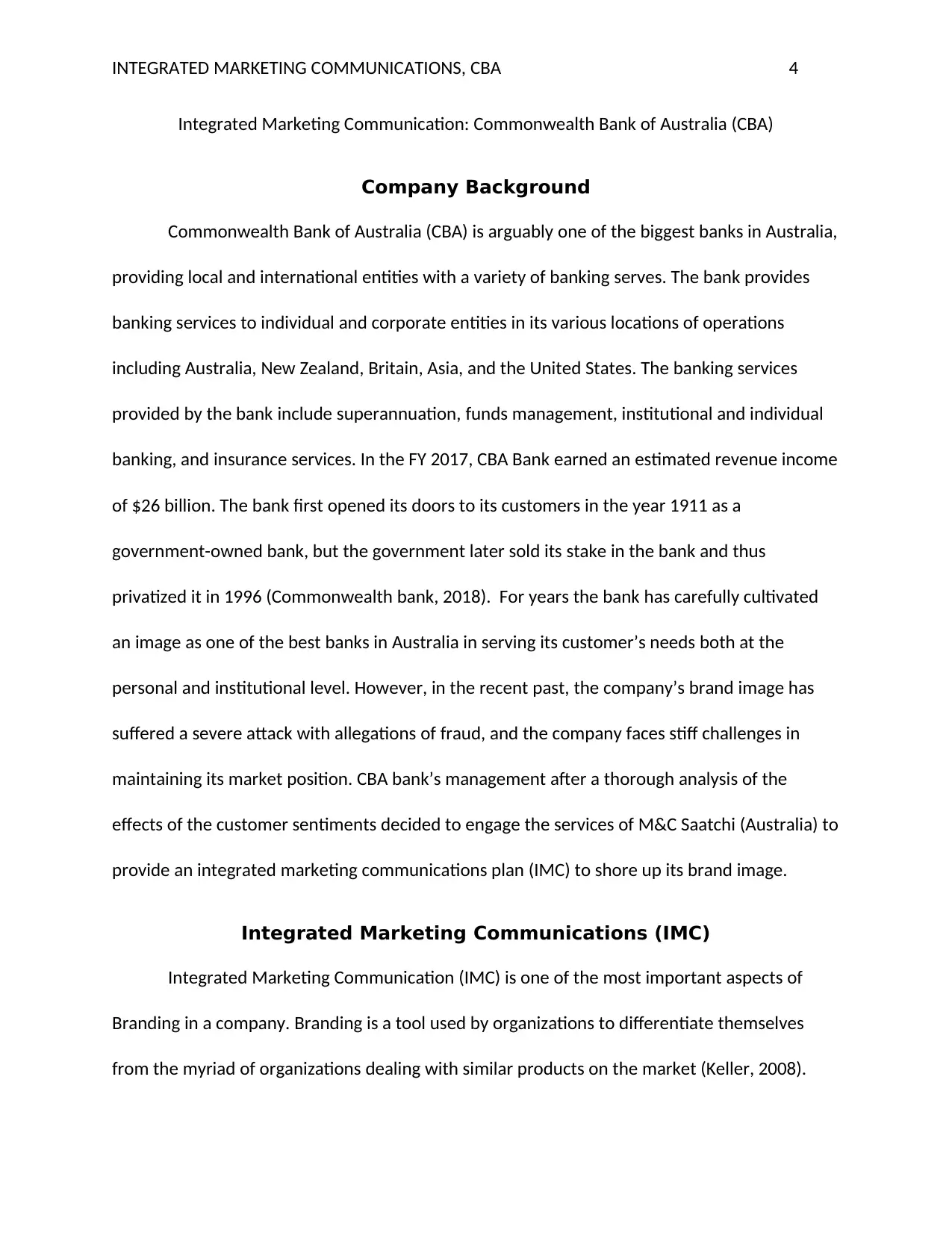
INTEGRATED MARKETING COMMUNICATIONS, CBA 4
Integrated Marketing Communication: Commonwealth Bank of Australia (CBA)
Company Background
Commonwealth Bank of Australia (CBA) is arguably one of the biggest banks in Australia,
providing local and international entities with a variety of banking serves. The bank provides
banking services to individual and corporate entities in its various locations of operations
including Australia, New Zealand, Britain, Asia, and the United States. The banking services
provided by the bank include superannuation, funds management, institutional and individual
banking, and insurance services. In the FY 2017, CBA Bank earned an estimated revenue income
of $26 billion. The bank first opened its doors to its customers in the year 1911 as a
government-owned bank, but the government later sold its stake in the bank and thus
privatized it in 1996 (Commonwealth bank, 2018). For years the bank has carefully cultivated
an image as one of the best banks in Australia in serving its customer’s needs both at the
personal and institutional level. However, in the recent past, the company’s brand image has
suffered a severe attack with allegations of fraud, and the company faces stiff challenges in
maintaining its market position. CBA bank’s management after a thorough analysis of the
effects of the customer sentiments decided to engage the services of M&C Saatchi (Australia) to
provide an integrated marketing communications plan (IMC) to shore up its brand image.
Integrated Marketing Communications (IMC)
Integrated Marketing Communication (IMC) is one of the most important aspects of
Branding in a company. Branding is a tool used by organizations to differentiate themselves
from the myriad of organizations dealing with similar products on the market (Keller, 2008).
Integrated Marketing Communication: Commonwealth Bank of Australia (CBA)
Company Background
Commonwealth Bank of Australia (CBA) is arguably one of the biggest banks in Australia,
providing local and international entities with a variety of banking serves. The bank provides
banking services to individual and corporate entities in its various locations of operations
including Australia, New Zealand, Britain, Asia, and the United States. The banking services
provided by the bank include superannuation, funds management, institutional and individual
banking, and insurance services. In the FY 2017, CBA Bank earned an estimated revenue income
of $26 billion. The bank first opened its doors to its customers in the year 1911 as a
government-owned bank, but the government later sold its stake in the bank and thus
privatized it in 1996 (Commonwealth bank, 2018). For years the bank has carefully cultivated
an image as one of the best banks in Australia in serving its customer’s needs both at the
personal and institutional level. However, in the recent past, the company’s brand image has
suffered a severe attack with allegations of fraud, and the company faces stiff challenges in
maintaining its market position. CBA bank’s management after a thorough analysis of the
effects of the customer sentiments decided to engage the services of M&C Saatchi (Australia) to
provide an integrated marketing communications plan (IMC) to shore up its brand image.
Integrated Marketing Communications (IMC)
Integrated Marketing Communication (IMC) is one of the most important aspects of
Branding in a company. Branding is a tool used by organizations to differentiate themselves
from the myriad of organizations dealing with similar products on the market (Keller, 2008).
Paraphrase This Document
Need a fresh take? Get an instant paraphrase of this document with our AI Paraphraser
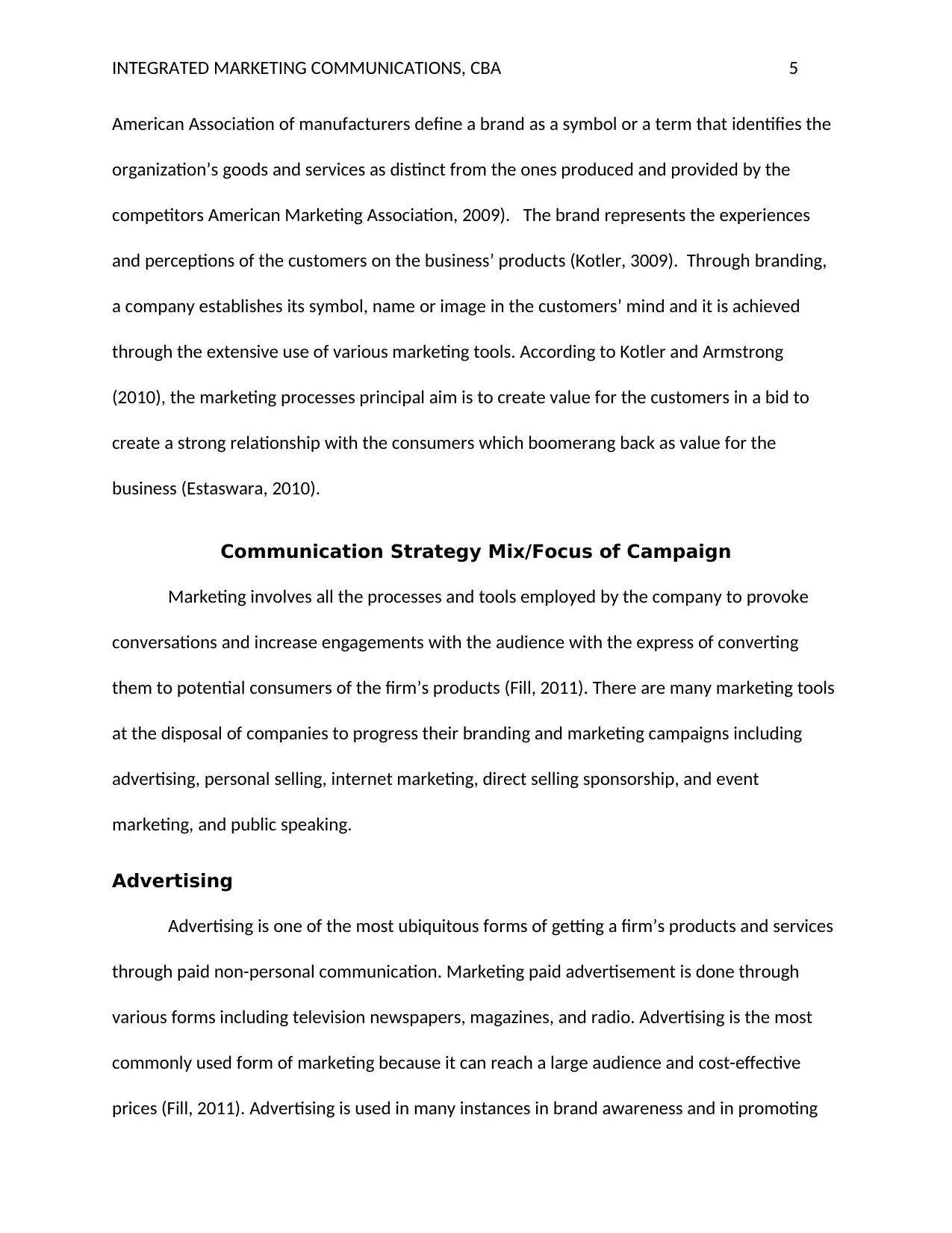
INTEGRATED MARKETING COMMUNICATIONS, CBA 5
American Association of manufacturers define a brand as a symbol or a term that identifies the
organization’s goods and services as distinct from the ones produced and provided by the
competitors American Marketing Association, 2009). The brand represents the experiences
and perceptions of the customers on the business’ products (Kotler, 3009). Through branding,
a company establishes its symbol, name or image in the customers’ mind and it is achieved
through the extensive use of various marketing tools. According to Kotler and Armstrong
(2010), the marketing processes principal aim is to create value for the customers in a bid to
create a strong relationship with the consumers which boomerang back as value for the
business (Estaswara, 2010).
Communication Strategy Mix/Focus of Campaign
Marketing involves all the processes and tools employed by the company to provoke
conversations and increase engagements with the audience with the express of converting
them to potential consumers of the firm’s products (Fill, 2011). There are many marketing tools
at the disposal of companies to progress their branding and marketing campaigns including
advertising, personal selling, internet marketing, direct selling sponsorship, and event
marketing, and public speaking.
Advertising
Advertising is one of the most ubiquitous forms of getting a firm’s products and services
through paid non-personal communication. Marketing paid advertisement is done through
various forms including television newspapers, magazines, and radio. Advertising is the most
commonly used form of marketing because it can reach a large audience and cost-effective
prices (Fill, 2011). Advertising is used in many instances in brand awareness and in promoting
American Association of manufacturers define a brand as a symbol or a term that identifies the
organization’s goods and services as distinct from the ones produced and provided by the
competitors American Marketing Association, 2009). The brand represents the experiences
and perceptions of the customers on the business’ products (Kotler, 3009). Through branding,
a company establishes its symbol, name or image in the customers’ mind and it is achieved
through the extensive use of various marketing tools. According to Kotler and Armstrong
(2010), the marketing processes principal aim is to create value for the customers in a bid to
create a strong relationship with the consumers which boomerang back as value for the
business (Estaswara, 2010).
Communication Strategy Mix/Focus of Campaign
Marketing involves all the processes and tools employed by the company to provoke
conversations and increase engagements with the audience with the express of converting
them to potential consumers of the firm’s products (Fill, 2011). There are many marketing tools
at the disposal of companies to progress their branding and marketing campaigns including
advertising, personal selling, internet marketing, direct selling sponsorship, and event
marketing, and public speaking.
Advertising
Advertising is one of the most ubiquitous forms of getting a firm’s products and services
through paid non-personal communication. Marketing paid advertisement is done through
various forms including television newspapers, magazines, and radio. Advertising is the most
commonly used form of marketing because it can reach a large audience and cost-effective
prices (Fill, 2011). Advertising is used in many instances in brand awareness and in promoting
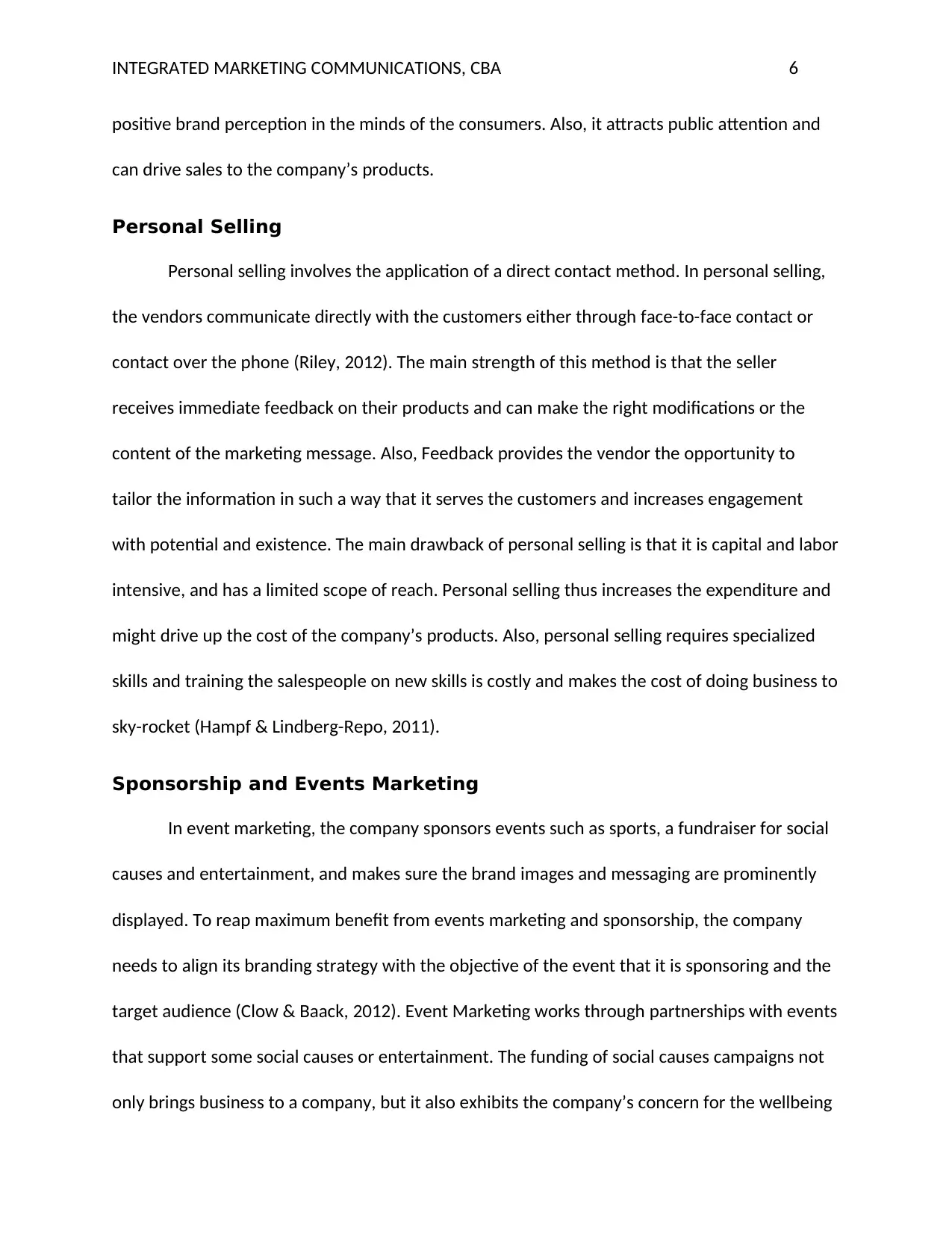
INTEGRATED MARKETING COMMUNICATIONS, CBA 6
positive brand perception in the minds of the consumers. Also, it attracts public attention and
can drive sales to the company’s products.
Personal Selling
Personal selling involves the application of a direct contact method. In personal selling,
the vendors communicate directly with the customers either through face-to-face contact or
contact over the phone (Riley, 2012). The main strength of this method is that the seller
receives immediate feedback on their products and can make the right modifications or the
content of the marketing message. Also, Feedback provides the vendor the opportunity to
tailor the information in such a way that it serves the customers and increases engagement
with potential and existence. The main drawback of personal selling is that it is capital and labor
intensive, and has a limited scope of reach. Personal selling thus increases the expenditure and
might drive up the cost of the company’s products. Also, personal selling requires specialized
skills and training the salespeople on new skills is costly and makes the cost of doing business to
sky-rocket (Hampf & Lindberg-Repo, 2011).
Sponsorship and Events Marketing
In event marketing, the company sponsors events such as sports, a fundraiser for social
causes and entertainment, and makes sure the brand images and messaging are prominently
displayed. To reap maximum benefit from events marketing and sponsorship, the company
needs to align its branding strategy with the objective of the event that it is sponsoring and the
target audience (Clow & Baack, 2012). Event Marketing works through partnerships with events
that support some social causes or entertainment. The funding of social causes campaigns not
only brings business to a company, but it also exhibits the company’s concern for the wellbeing
positive brand perception in the minds of the consumers. Also, it attracts public attention and
can drive sales to the company’s products.
Personal Selling
Personal selling involves the application of a direct contact method. In personal selling,
the vendors communicate directly with the customers either through face-to-face contact or
contact over the phone (Riley, 2012). The main strength of this method is that the seller
receives immediate feedback on their products and can make the right modifications or the
content of the marketing message. Also, Feedback provides the vendor the opportunity to
tailor the information in such a way that it serves the customers and increases engagement
with potential and existence. The main drawback of personal selling is that it is capital and labor
intensive, and has a limited scope of reach. Personal selling thus increases the expenditure and
might drive up the cost of the company’s products. Also, personal selling requires specialized
skills and training the salespeople on new skills is costly and makes the cost of doing business to
sky-rocket (Hampf & Lindberg-Repo, 2011).
Sponsorship and Events Marketing
In event marketing, the company sponsors events such as sports, a fundraiser for social
causes and entertainment, and makes sure the brand images and messaging are prominently
displayed. To reap maximum benefit from events marketing and sponsorship, the company
needs to align its branding strategy with the objective of the event that it is sponsoring and the
target audience (Clow & Baack, 2012). Event Marketing works through partnerships with events
that support some social causes or entertainment. The funding of social causes campaigns not
only brings business to a company, but it also exhibits the company’s concern for the wellbeing
⊘ This is a preview!⊘
Do you want full access?
Subscribe today to unlock all pages.

Trusted by 1+ million students worldwide
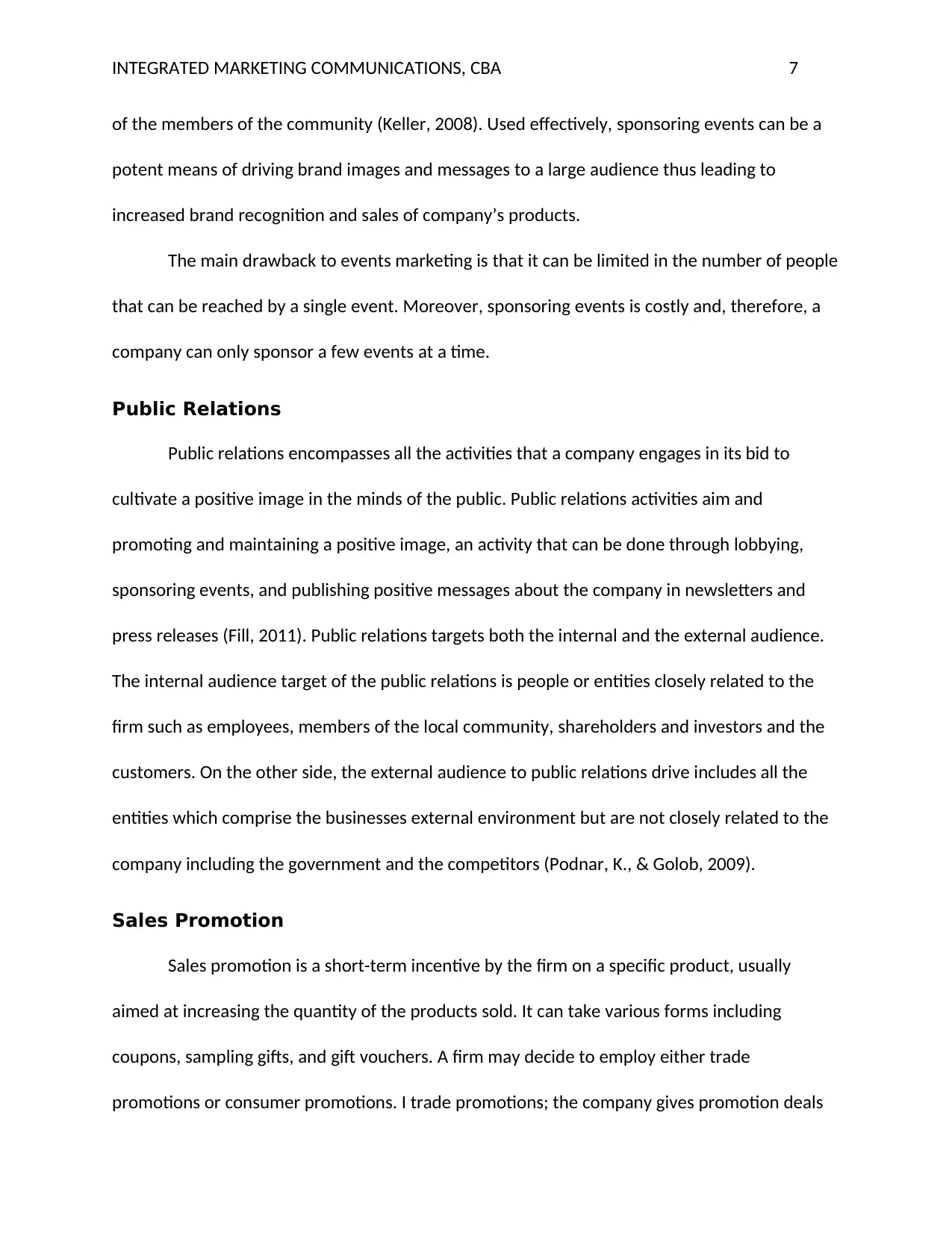
INTEGRATED MARKETING COMMUNICATIONS, CBA 7
of the members of the community (Keller, 2008). Used effectively, sponsoring events can be a
potent means of driving brand images and messages to a large audience thus leading to
increased brand recognition and sales of company’s products.
The main drawback to events marketing is that it can be limited in the number of people
that can be reached by a single event. Moreover, sponsoring events is costly and, therefore, a
company can only sponsor a few events at a time.
Public Relations
Public relations encompasses all the activities that a company engages in its bid to
cultivate a positive image in the minds of the public. Public relations activities aim and
promoting and maintaining a positive image, an activity that can be done through lobbying,
sponsoring events, and publishing positive messages about the company in newsletters and
press releases (Fill, 2011). Public relations targets both the internal and the external audience.
The internal audience target of the public relations is people or entities closely related to the
firm such as employees, members of the local community, shareholders and investors and the
customers. On the other side, the external audience to public relations drive includes all the
entities which comprise the businesses external environment but are not closely related to the
company including the government and the competitors (Podnar, K., & Golob, 2009).
Sales Promotion
Sales promotion is a short-term incentive by the firm on a specific product, usually
aimed at increasing the quantity of the products sold. It can take various forms including
coupons, sampling gifts, and gift vouchers. A firm may decide to employ either trade
promotions or consumer promotions. I trade promotions; the company gives promotion deals
of the members of the community (Keller, 2008). Used effectively, sponsoring events can be a
potent means of driving brand images and messages to a large audience thus leading to
increased brand recognition and sales of company’s products.
The main drawback to events marketing is that it can be limited in the number of people
that can be reached by a single event. Moreover, sponsoring events is costly and, therefore, a
company can only sponsor a few events at a time.
Public Relations
Public relations encompasses all the activities that a company engages in its bid to
cultivate a positive image in the minds of the public. Public relations activities aim and
promoting and maintaining a positive image, an activity that can be done through lobbying,
sponsoring events, and publishing positive messages about the company in newsletters and
press releases (Fill, 2011). Public relations targets both the internal and the external audience.
The internal audience target of the public relations is people or entities closely related to the
firm such as employees, members of the local community, shareholders and investors and the
customers. On the other side, the external audience to public relations drive includes all the
entities which comprise the businesses external environment but are not closely related to the
company including the government and the competitors (Podnar, K., & Golob, 2009).
Sales Promotion
Sales promotion is a short-term incentive by the firm on a specific product, usually
aimed at increasing the quantity of the products sold. It can take various forms including
coupons, sampling gifts, and gift vouchers. A firm may decide to employ either trade
promotions or consumer promotions. I trade promotions; the company gives promotion deals
Paraphrase This Document
Need a fresh take? Get an instant paraphrase of this document with our AI Paraphraser
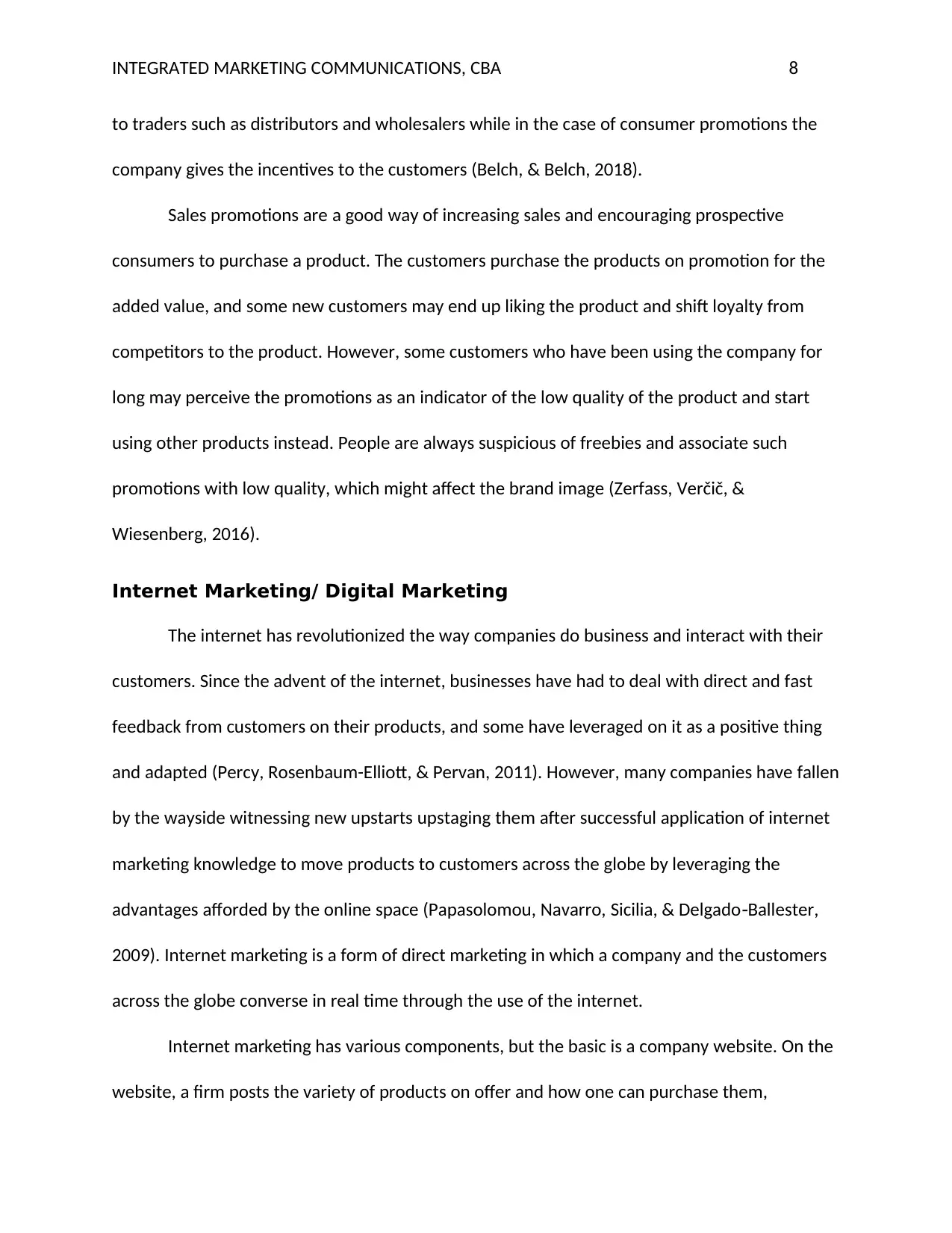
INTEGRATED MARKETING COMMUNICATIONS, CBA 8
to traders such as distributors and wholesalers while in the case of consumer promotions the
company gives the incentives to the customers (Belch, & Belch, 2018).
Sales promotions are a good way of increasing sales and encouraging prospective
consumers to purchase a product. The customers purchase the products on promotion for the
added value, and some new customers may end up liking the product and shift loyalty from
competitors to the product. However, some customers who have been using the company for
long may perceive the promotions as an indicator of the low quality of the product and start
using other products instead. People are always suspicious of freebies and associate such
promotions with low quality, which might affect the brand image (Zerfass, Verčič, &
Wiesenberg, 2016).
Internet Marketing/ Digital Marketing
The internet has revolutionized the way companies do business and interact with their
customers. Since the advent of the internet, businesses have had to deal with direct and fast
feedback from customers on their products, and some have leveraged on it as a positive thing
and adapted (Percy, Rosenbaum-Elliott, & Pervan, 2011). However, many companies have fallen
by the wayside witnessing new upstarts upstaging them after successful application of internet
marketing knowledge to move products to customers across the globe by leveraging the
advantages afforded by the online space (Papasolomou, Navarro, Sicilia, & Delgado Ballester,‐
2009). Internet marketing is a form of direct marketing in which a company and the customers
across the globe converse in real time through the use of the internet.
Internet marketing has various components, but the basic is a company website. On the
website, a firm posts the variety of products on offer and how one can purchase them,
to traders such as distributors and wholesalers while in the case of consumer promotions the
company gives the incentives to the customers (Belch, & Belch, 2018).
Sales promotions are a good way of increasing sales and encouraging prospective
consumers to purchase a product. The customers purchase the products on promotion for the
added value, and some new customers may end up liking the product and shift loyalty from
competitors to the product. However, some customers who have been using the company for
long may perceive the promotions as an indicator of the low quality of the product and start
using other products instead. People are always suspicious of freebies and associate such
promotions with low quality, which might affect the brand image (Zerfass, Verčič, &
Wiesenberg, 2016).
Internet Marketing/ Digital Marketing
The internet has revolutionized the way companies do business and interact with their
customers. Since the advent of the internet, businesses have had to deal with direct and fast
feedback from customers on their products, and some have leveraged on it as a positive thing
and adapted (Percy, Rosenbaum-Elliott, & Pervan, 2011). However, many companies have fallen
by the wayside witnessing new upstarts upstaging them after successful application of internet
marketing knowledge to move products to customers across the globe by leveraging the
advantages afforded by the online space (Papasolomou, Navarro, Sicilia, & Delgado Ballester,‐
2009). Internet marketing is a form of direct marketing in which a company and the customers
across the globe converse in real time through the use of the internet.
Internet marketing has various components, but the basic is a company website. On the
website, a firm posts the variety of products on offer and how one can purchase them,
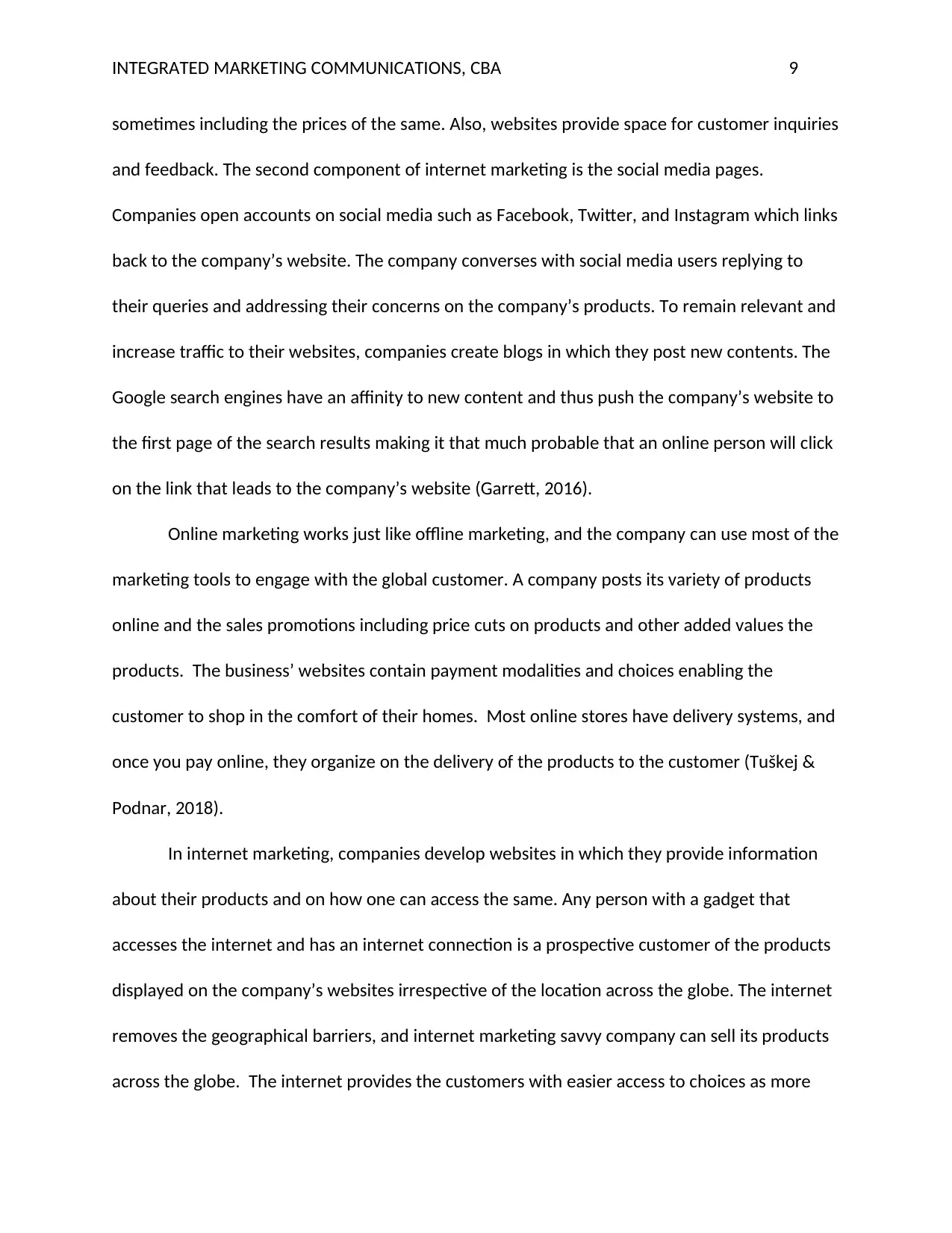
INTEGRATED MARKETING COMMUNICATIONS, CBA 9
sometimes including the prices of the same. Also, websites provide space for customer inquiries
and feedback. The second component of internet marketing is the social media pages.
Companies open accounts on social media such as Facebook, Twitter, and Instagram which links
back to the company’s website. The company converses with social media users replying to
their queries and addressing their concerns on the company’s products. To remain relevant and
increase traffic to their websites, companies create blogs in which they post new contents. The
Google search engines have an affinity to new content and thus push the company’s website to
the first page of the search results making it that much probable that an online person will click
on the link that leads to the company’s website (Garrett, 2016).
Online marketing works just like offline marketing, and the company can use most of the
marketing tools to engage with the global customer. A company posts its variety of products
online and the sales promotions including price cuts on products and other added values the
products. The business’ websites contain payment modalities and choices enabling the
customer to shop in the comfort of their homes. Most online stores have delivery systems, and
once you pay online, they organize on the delivery of the products to the customer (Tuškej &
Podnar, 2018).
In internet marketing, companies develop websites in which they provide information
about their products and on how one can access the same. Any person with a gadget that
accesses the internet and has an internet connection is a prospective customer of the products
displayed on the company’s websites irrespective of the location across the globe. The internet
removes the geographical barriers, and internet marketing savvy company can sell its products
across the globe. The internet provides the customers with easier access to choices as more
sometimes including the prices of the same. Also, websites provide space for customer inquiries
and feedback. The second component of internet marketing is the social media pages.
Companies open accounts on social media such as Facebook, Twitter, and Instagram which links
back to the company’s website. The company converses with social media users replying to
their queries and addressing their concerns on the company’s products. To remain relevant and
increase traffic to their websites, companies create blogs in which they post new contents. The
Google search engines have an affinity to new content and thus push the company’s website to
the first page of the search results making it that much probable that an online person will click
on the link that leads to the company’s website (Garrett, 2016).
Online marketing works just like offline marketing, and the company can use most of the
marketing tools to engage with the global customer. A company posts its variety of products
online and the sales promotions including price cuts on products and other added values the
products. The business’ websites contain payment modalities and choices enabling the
customer to shop in the comfort of their homes. Most online stores have delivery systems, and
once you pay online, they organize on the delivery of the products to the customer (Tuškej &
Podnar, 2018).
In internet marketing, companies develop websites in which they provide information
about their products and on how one can access the same. Any person with a gadget that
accesses the internet and has an internet connection is a prospective customer of the products
displayed on the company’s websites irrespective of the location across the globe. The internet
removes the geographical barriers, and internet marketing savvy company can sell its products
across the globe. The internet provides the customers with easier access to choices as more
⊘ This is a preview!⊘
Do you want full access?
Subscribe today to unlock all pages.

Trusted by 1+ million students worldwide
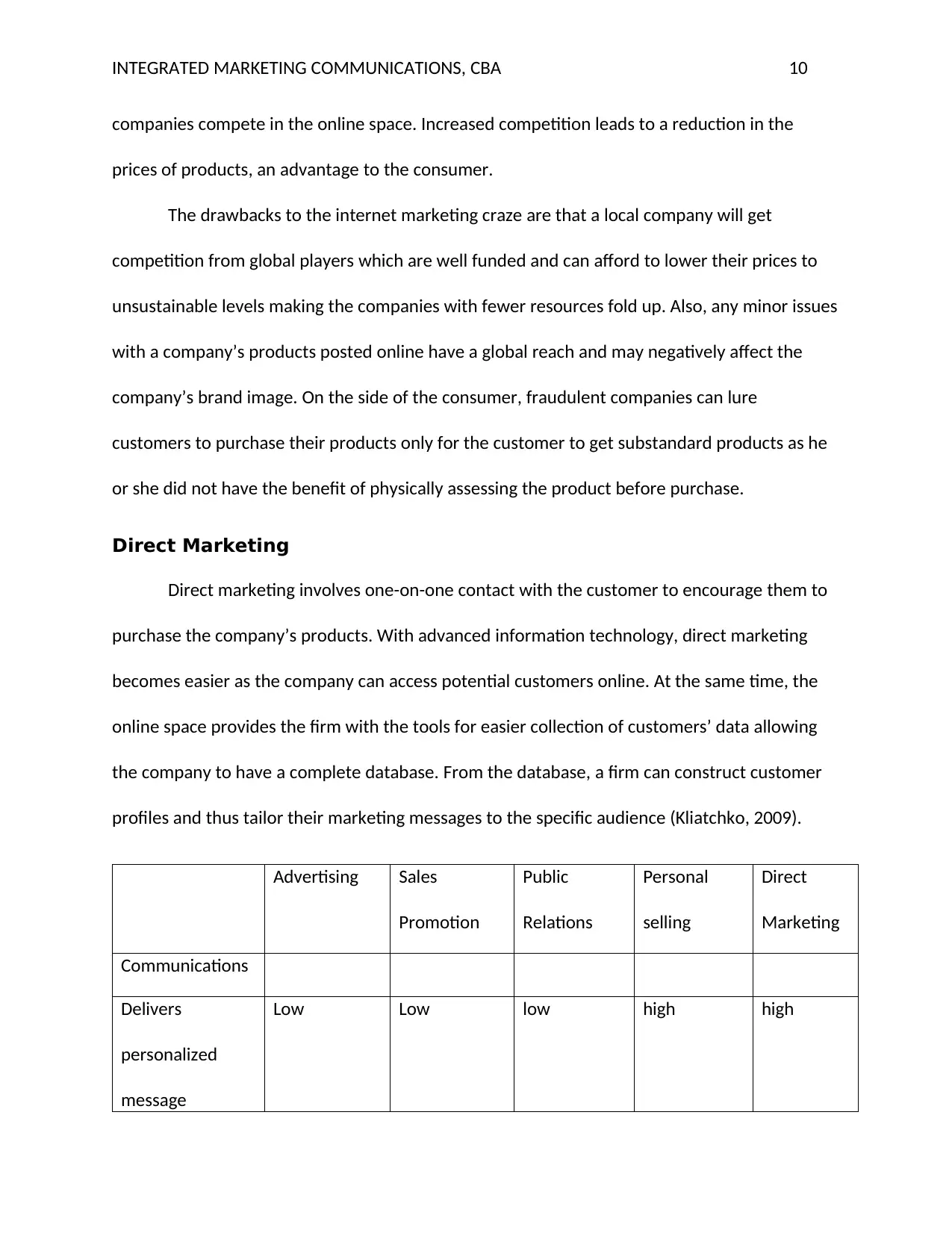
INTEGRATED MARKETING COMMUNICATIONS, CBA 10
companies compete in the online space. Increased competition leads to a reduction in the
prices of products, an advantage to the consumer.
The drawbacks to the internet marketing craze are that a local company will get
competition from global players which are well funded and can afford to lower their prices to
unsustainable levels making the companies with fewer resources fold up. Also, any minor issues
with a company’s products posted online have a global reach and may negatively affect the
company’s brand image. On the side of the consumer, fraudulent companies can lure
customers to purchase their products only for the customer to get substandard products as he
or she did not have the benefit of physically assessing the product before purchase.
Direct Marketing
Direct marketing involves one-on-one contact with the customer to encourage them to
purchase the company’s products. With advanced information technology, direct marketing
becomes easier as the company can access potential customers online. At the same time, the
online space provides the firm with the tools for easier collection of customers’ data allowing
the company to have a complete database. From the database, a firm can construct customer
profiles and thus tailor their marketing messages to the specific audience (Kliatchko, 2009).
Advertising Sales
Promotion
Public
Relations
Personal
selling
Direct
Marketing
Communications
Delivers
personalized
message
Low Low low high high
companies compete in the online space. Increased competition leads to a reduction in the
prices of products, an advantage to the consumer.
The drawbacks to the internet marketing craze are that a local company will get
competition from global players which are well funded and can afford to lower their prices to
unsustainable levels making the companies with fewer resources fold up. Also, any minor issues
with a company’s products posted online have a global reach and may negatively affect the
company’s brand image. On the side of the consumer, fraudulent companies can lure
customers to purchase their products only for the customer to get substandard products as he
or she did not have the benefit of physically assessing the product before purchase.
Direct Marketing
Direct marketing involves one-on-one contact with the customer to encourage them to
purchase the company’s products. With advanced information technology, direct marketing
becomes easier as the company can access potential customers online. At the same time, the
online space provides the firm with the tools for easier collection of customers’ data allowing
the company to have a complete database. From the database, a firm can construct customer
profiles and thus tailor their marketing messages to the specific audience (Kliatchko, 2009).
Advertising Sales
Promotion
Public
Relations
Personal
selling
Direct
Marketing
Communications
Delivers
personalized
message
Low Low low high high
Paraphrase This Document
Need a fresh take? Get an instant paraphrase of this document with our AI Paraphraser
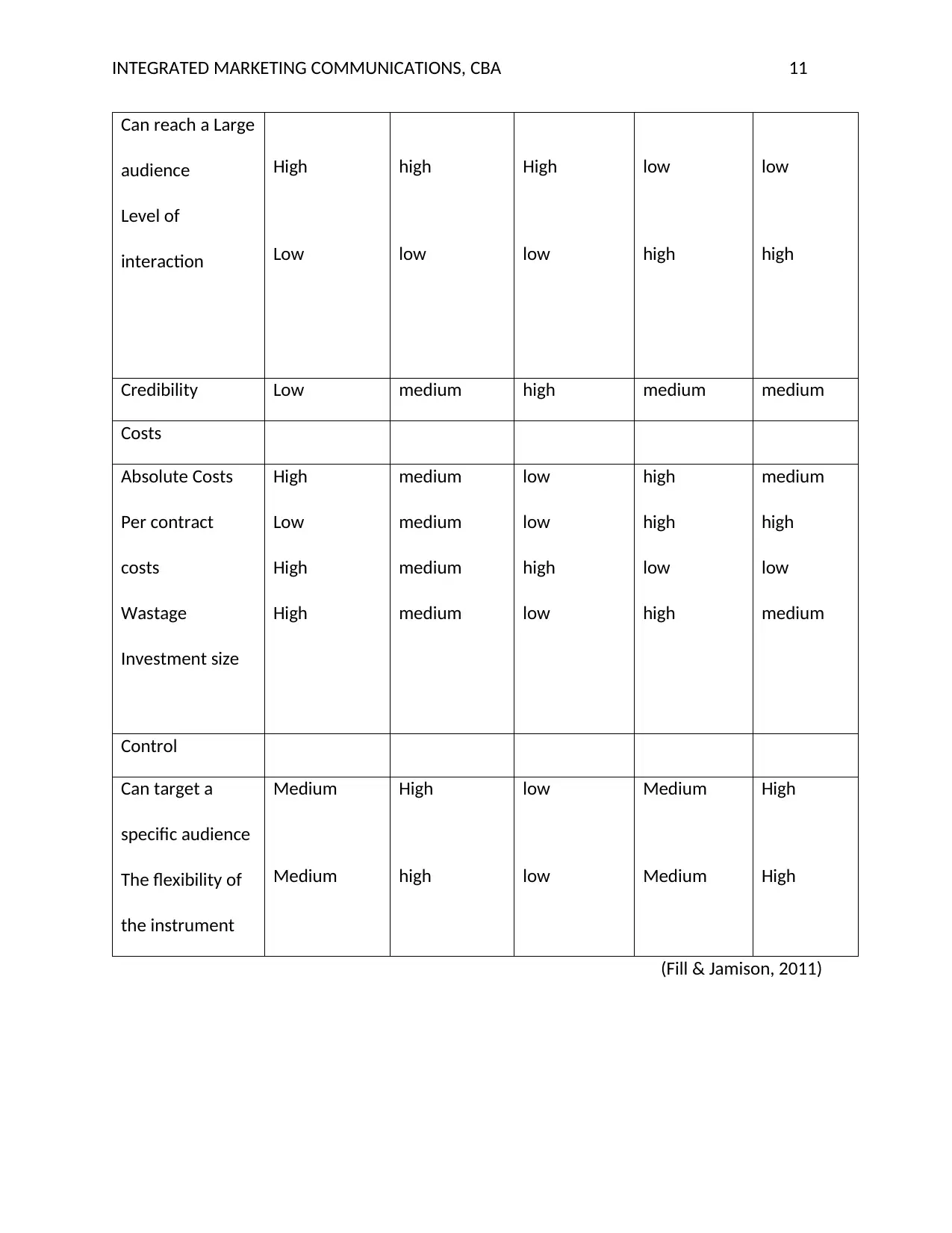
INTEGRATED MARKETING COMMUNICATIONS, CBA 11
Can reach a Large
audience
Level of
interaction
High
Low
high
low
High
low
low
high
low
high
Credibility Low medium high medium medium
Costs
Absolute Costs
Per contract
costs
Wastage
Investment size
High
Low
High
High
medium
medium
medium
medium
low
low
high
low
high
high
low
high
medium
high
low
medium
Control
Can target a
specific audience
The flexibility of
the instrument
Medium
Medium
High
high
low
low
Medium
Medium
High
High
(Fill & Jamison, 2011)
Can reach a Large
audience
Level of
interaction
High
Low
high
low
High
low
low
high
low
high
Credibility Low medium high medium medium
Costs
Absolute Costs
Per contract
costs
Wastage
Investment size
High
Low
High
High
medium
medium
medium
medium
low
low
high
low
high
high
low
high
medium
high
low
medium
Control
Can target a
specific audience
The flexibility of
the instrument
Medium
Medium
High
high
low
low
Medium
Medium
High
High
(Fill & Jamison, 2011)
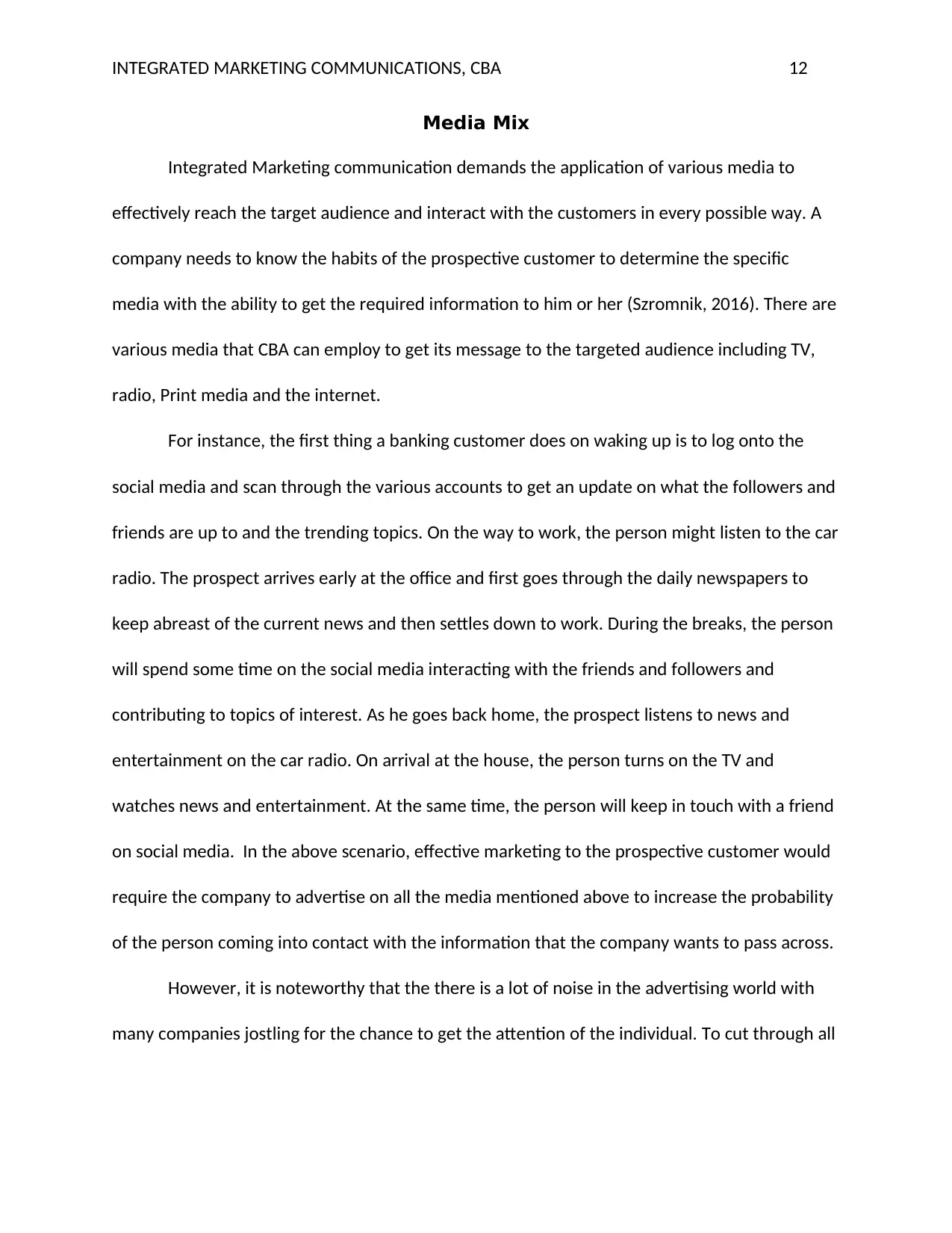
INTEGRATED MARKETING COMMUNICATIONS, CBA 12
Media Mix
Integrated Marketing communication demands the application of various media to
effectively reach the target audience and interact with the customers in every possible way. A
company needs to know the habits of the prospective customer to determine the specific
media with the ability to get the required information to him or her (Szromnik, 2016). There are
various media that CBA can employ to get its message to the targeted audience including TV,
radio, Print media and the internet.
For instance, the first thing a banking customer does on waking up is to log onto the
social media and scan through the various accounts to get an update on what the followers and
friends are up to and the trending topics. On the way to work, the person might listen to the car
radio. The prospect arrives early at the office and first goes through the daily newspapers to
keep abreast of the current news and then settles down to work. During the breaks, the person
will spend some time on the social media interacting with the friends and followers and
contributing to topics of interest. As he goes back home, the prospect listens to news and
entertainment on the car radio. On arrival at the house, the person turns on the TV and
watches news and entertainment. At the same time, the person will keep in touch with a friend
on social media. In the above scenario, effective marketing to the prospective customer would
require the company to advertise on all the media mentioned above to increase the probability
of the person coming into contact with the information that the company wants to pass across.
However, it is noteworthy that the there is a lot of noise in the advertising world with
many companies jostling for the chance to get the attention of the individual. To cut through all
Media Mix
Integrated Marketing communication demands the application of various media to
effectively reach the target audience and interact with the customers in every possible way. A
company needs to know the habits of the prospective customer to determine the specific
media with the ability to get the required information to him or her (Szromnik, 2016). There are
various media that CBA can employ to get its message to the targeted audience including TV,
radio, Print media and the internet.
For instance, the first thing a banking customer does on waking up is to log onto the
social media and scan through the various accounts to get an update on what the followers and
friends are up to and the trending topics. On the way to work, the person might listen to the car
radio. The prospect arrives early at the office and first goes through the daily newspapers to
keep abreast of the current news and then settles down to work. During the breaks, the person
will spend some time on the social media interacting with the friends and followers and
contributing to topics of interest. As he goes back home, the prospect listens to news and
entertainment on the car radio. On arrival at the house, the person turns on the TV and
watches news and entertainment. At the same time, the person will keep in touch with a friend
on social media. In the above scenario, effective marketing to the prospective customer would
require the company to advertise on all the media mentioned above to increase the probability
of the person coming into contact with the information that the company wants to pass across.
However, it is noteworthy that the there is a lot of noise in the advertising world with
many companies jostling for the chance to get the attention of the individual. To cut through all
⊘ This is a preview!⊘
Do you want full access?
Subscribe today to unlock all pages.

Trusted by 1+ million students worldwide
1 out of 21
Related Documents
Your All-in-One AI-Powered Toolkit for Academic Success.
+13062052269
info@desklib.com
Available 24*7 on WhatsApp / Email
![[object Object]](/_next/static/media/star-bottom.7253800d.svg)
Unlock your academic potential
Copyright © 2020–2025 A2Z Services. All Rights Reserved. Developed and managed by ZUCOL.


